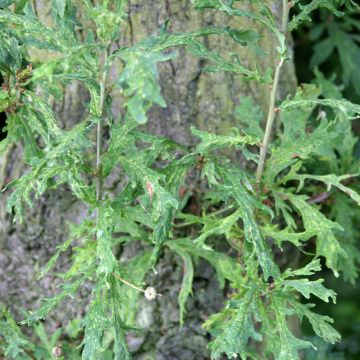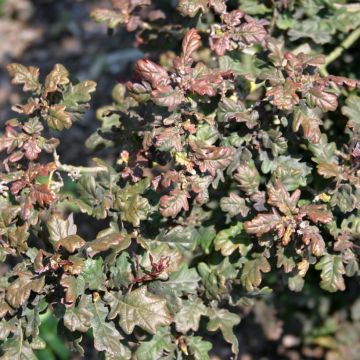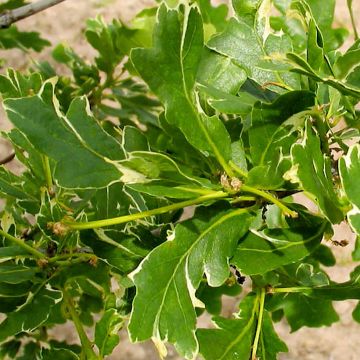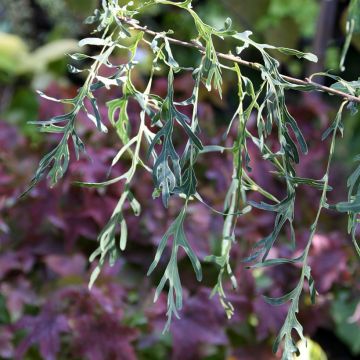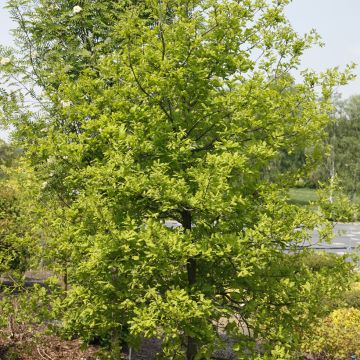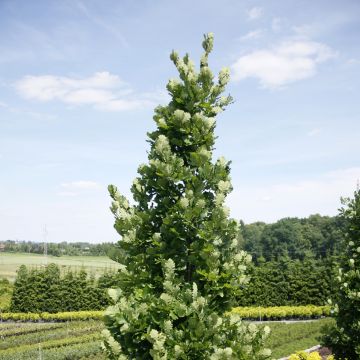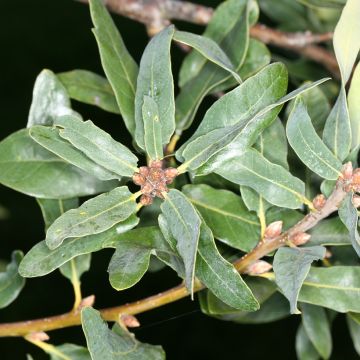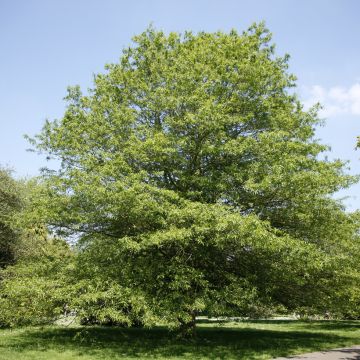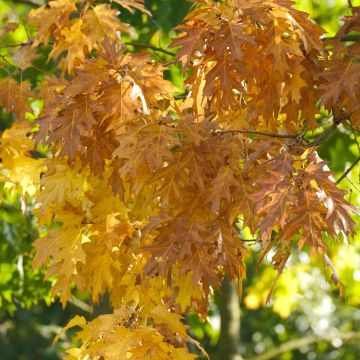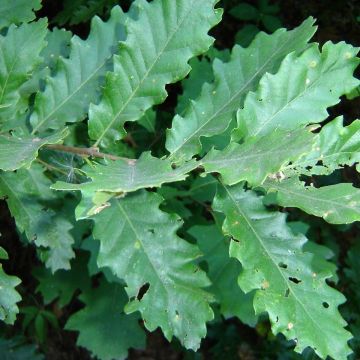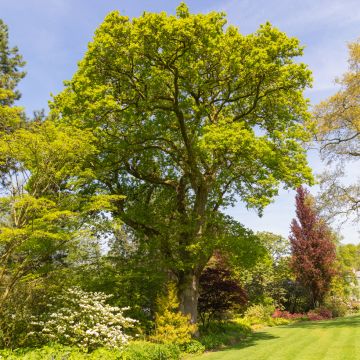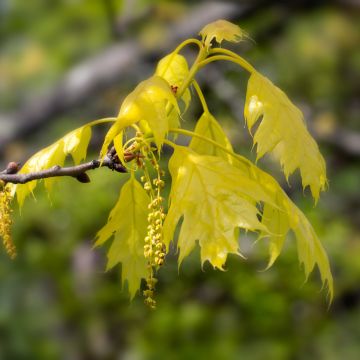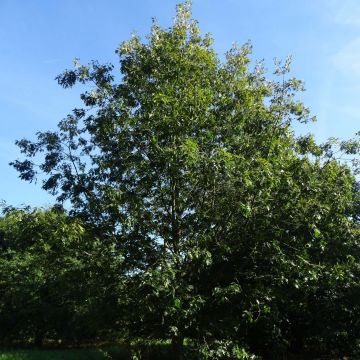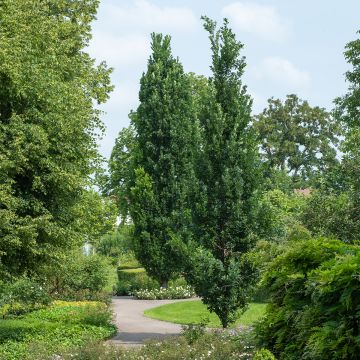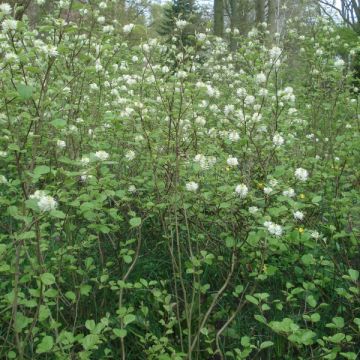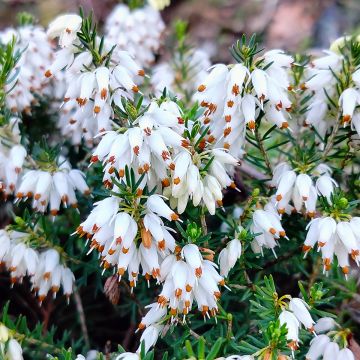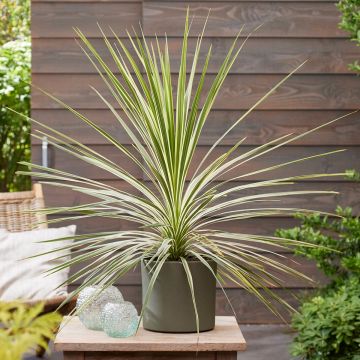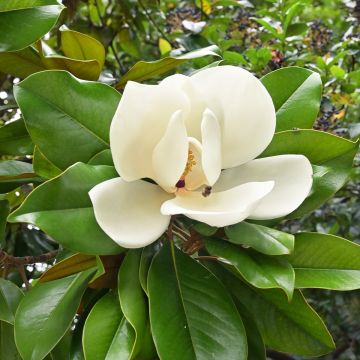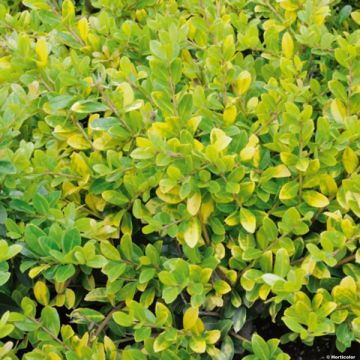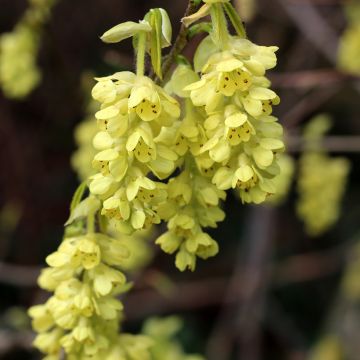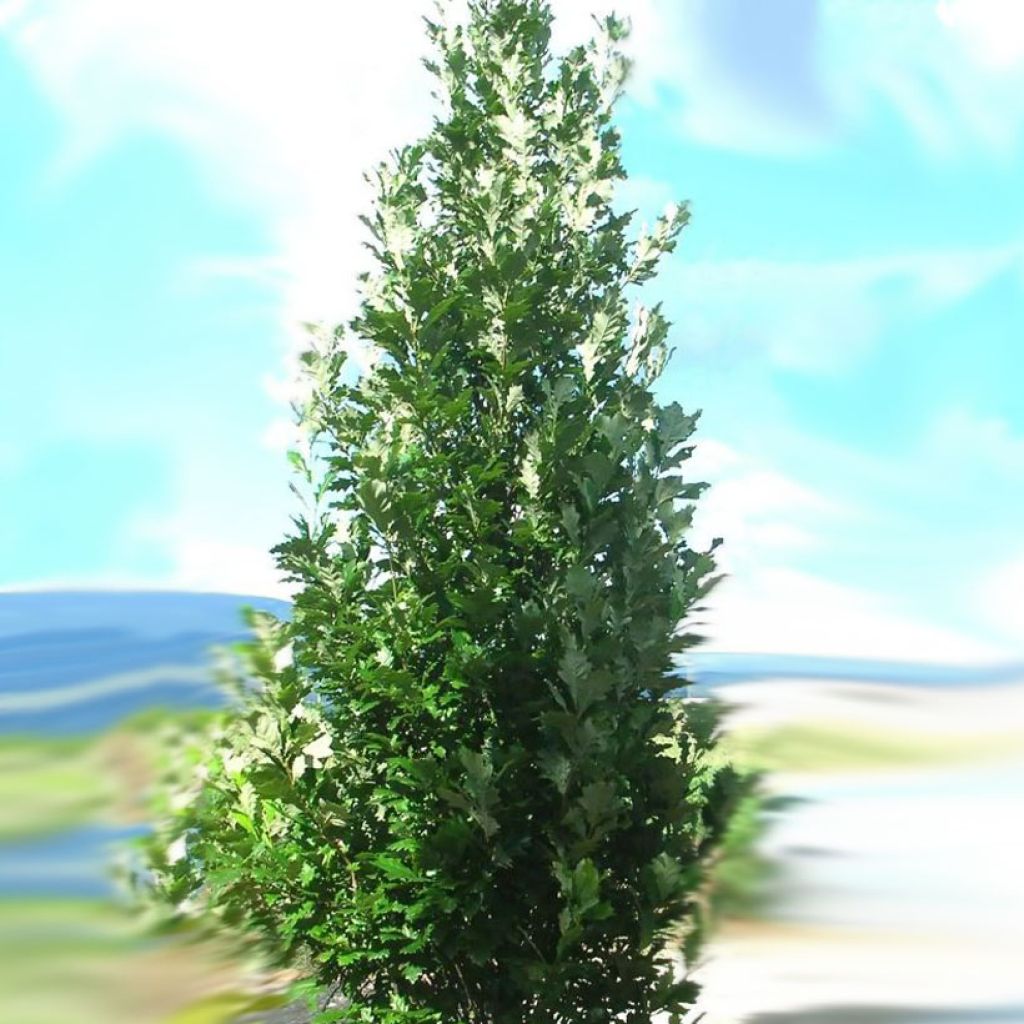

Quercus x warei Regal Prince - Oak
Quercus x warei Regal Prince - Oak
Quercus x warei 'Long' REGAL PRINCE
Oak
Why not try an alternative variety in stock?
View all →This plant carries a 24 months recovery warranty
More information
We guarantee the quality of our plants for a full growing cycle, and will replace at our expense any plant that fails to recover under normal climatic and planting conditions.
Does this plant fit my garden?
Set up your Plantfit profile →
Description
Quercus x warei 'Regal Prince' is a medium-sized hybrid oak with a very architectural fastigiate habit, making it interesting for gardens with limited space and contemporary scenes. It bears decorative, large, dark green lobed leaves which turn yellow-brown mixed with orange in autumn. They are marcescent and persist on the branches throughout winter before eventually falling to the ground. This very hardy, beautiful tree thrives in deep soil, preferably moist, neutral to acidic. It enjoys sunny locations and requires little maintenance, being quite resistant to diseases.
The Oak is one of the main members of the Fagaceae family, alongside Beeches (Fagus) and Chestnuts (Castanea). There are at least 250 species of Oaks, and many more when counting the numerous hybrids. This cosmopolitan genus grows naturally in both the northern hemisphere and the tropics, in South America, and even in Southeast Asia.
The 'Regal Prince' Oak is a hybrid obtained in Jacksonville (USA) by Earl Cully in 1974 by cross-breeding Quercus robur 'Fastigiata', a variety of pedunculate oak with a columnar habit, and Quercus bicolor, a North American species that grows in wet areas. The goal was to produce a columnar Oak with improved hardiness, and the result of this cross-breeding was patented in 1998. This Oak exhibits a very fastigiate habit in its juvenile state, which broadens slightly into an elongated cone shape at maturity. 10 years after planting, it will reach 10 m in height with a width of only about 4 m, and at maturity, it can reach 15 m tall with a spread of 6 m. Its architectural silhouette also has the advantage of not being affected by wind gusts or snowfalls, with the branches remaining well erect. The ovate to obovate leaves are larger than those of the pedunculate Oak and are irregularly lobed. They grow alternately on the branches and are adorned with ten to twelve lobes. Dark green on top with a glossy surface, the underside is grey-green. The young branches are brown-grey while the mature bark is grey-green. The spring flowering, typically in April-May, is yellow-green, insignificant, and of no ornamental interest. The fruits are acorns measuring 2.5 cm, covered halfway by a scaly cupule. In autumn, the foliage takes on amber-yellow hues, oscillating between brown and orange, which are not particularly spectacular but still relatively decorative. As with many species, the foliage is described as marcescent, as it remains on the tree throughout winter before falling to the ground to make way for new leaves.
The 'Regal Prince' Oak will find its place in a contemporary setting, where its architectural silhouette will be perfectly highlighted. It can also be planted confidently in a garden with limited space, as it will not risk becoming invasive. Planted in the background of a flowerbed, its lofty stature will complement other ornamental plants with decorative habits. A weeping purple Beech (Fagus sylvatica 'Purpurea Pendula') will create a double contrast of shape and colour. You may also integrate a variegated plant into your scene to bring light amidst these dark foliage. Cornus controversa 'Variegata', a Dogwood with white variegated foliage and layered pagoda-like growth, will be a welcome addition, provided you are patient, as its growth is not very rapid. To energise your flowerbed, opt for Cercis canadensis 'Hearts of Gold', which will offer you an early pink-violet flowering directly on the wood, before the appearance of beautiful heart-shaped leaves that transition from red in spring to yellow and then chartreuse green in summer, providing a permanent spectacle!
Report an error about the product description
Plant habit
Flowering
Foliage
Botanical data
Quercus
x warei
'Long' REGAL PRINCE
Fagaceae
Oak
Quercus x warei REGAL PRINCE, Quercus x warei 'Long', Quercus bicolor REGAL PRINCE
Cultivar or hybrid
Other Oak
View all →Planting and care
Quercus x warei 'Regal Prince' grows in ordinary, but deep, moist soil, preferably neutral or slightly acidic. Initially sensitive to drought, once established, this deep-rooted tree withstands normal summers and requires no watering at all. This oak thrives in most locations. It appreciates slightly moist, yet well-drained soils, where its growth will be faster. It prefers very sunny and open exposures. Place a sturdy stake to help it get started, follow up with watering, and then let nature take its course. This tree, once established, requires very little maintenance apart from the removal of dead wood. It is not very susceptible to diseases, highly resistant to powdery mildew and gall. It copes well with gusts of wind without suffering damage to its branches.
Planting period
Intended location
Care
This item has not been reviewed yet - be the first to leave a review about it.
Similar products
Haven't found what you were looking for?
Hardiness is the lowest winter temperature a plant can endure without suffering serious damage or even dying. However, hardiness is affected by location (a sheltered area, such as a patio), protection (winter cover) and soil type (hardiness is improved by well-drained soil).

Photo Sharing Terms & Conditions
In order to encourage gardeners to interact and share their experiences, Promesse de fleurs offers various media enabling content to be uploaded onto its Site - in particular via the ‘Photo sharing’ module.
The User agrees to refrain from:
- Posting any content that is illegal, prejudicial, insulting, racist, inciteful to hatred, revisionist, contrary to public decency, that infringes on privacy or on the privacy rights of third parties, in particular the publicity rights of persons and goods, intellectual property rights, or the right to privacy.
- Submitting content on behalf of a third party;
- Impersonate the identity of a third party and/or publish any personal information about a third party;
In general, the User undertakes to refrain from any unethical behaviour.
All Content (in particular text, comments, files, images, photos, videos, creative works, etc.), which may be subject to property or intellectual property rights, image or other private rights, shall remain the property of the User, subject to the limited rights granted by the terms of the licence granted by Promesse de fleurs as stated below. Users are at liberty to publish or not to publish such Content on the Site, notably via the ‘Photo Sharing’ facility, and accept that this Content shall be made public and freely accessible, notably on the Internet.
Users further acknowledge, undertake to have ,and guarantee that they hold all necessary rights and permissions to publish such material on the Site, in particular with regard to the legislation in force pertaining to any privacy, property, intellectual property, image, or contractual rights, or rights of any other nature. By publishing such Content on the Site, Users acknowledge accepting full liability as publishers of the Content within the meaning of the law, and grant Promesse de fleurs, free of charge, an inclusive, worldwide licence for the said Content for the entire duration of its publication, including all reproduction, representation, up/downloading, displaying, performing, transmission, and storage rights.
Users also grant permission for their name to be linked to the Content and accept that this link may not always be made available.
By engaging in posting material, Users consent to their Content becoming automatically accessible on the Internet, in particular on other sites and/or blogs and/or web pages of the Promesse de fleurs site, including in particular social pages and the Promesse de fleurs catalogue.
Users may secure the removal of entrusted content free of charge by issuing a simple request via our contact form.
The flowering period indicated on our website applies to countries and regions located in USDA zone 8 (France, the United Kingdom, Ireland, the Netherlands, etc.)
It will vary according to where you live:
- In zones 9 to 10 (Italy, Spain, Greece, etc.), flowering will occur about 2 to 4 weeks earlier.
- In zones 6 to 7 (Germany, Poland, Slovenia, and lower mountainous regions), flowering will be delayed by 2 to 3 weeks.
- In zone 5 (Central Europe, Scandinavia), blooming will be delayed by 3 to 5 weeks.
In temperate climates, pruning of spring-flowering shrubs (forsythia, spireas, etc.) should be done just after flowering.
Pruning of summer-flowering shrubs (Indian Lilac, Perovskia, etc.) can be done in winter or spring.
In cold regions as well as with frost-sensitive plants, avoid pruning too early when severe frosts may still occur.
The planting period indicated on our website applies to countries and regions located in USDA zone 8 (France, United Kingdom, Ireland, Netherlands).
It will vary according to where you live:
- In Mediterranean zones (Marseille, Madrid, Milan, etc.), autumn and winter are the best planting periods.
- In continental zones (Strasbourg, Munich, Vienna, etc.), delay planting by 2 to 3 weeks in spring and bring it forward by 2 to 4 weeks in autumn.
- In mountainous regions (the Alps, Pyrenees, Carpathians, etc.), it is best to plant in late spring (May-June) or late summer (August-September).
The harvesting period indicated on our website applies to countries and regions in USDA zone 8 (France, England, Ireland, the Netherlands).
In colder areas (Scandinavia, Poland, Austria...) fruit and vegetable harvests are likely to be delayed by 3-4 weeks.
In warmer areas (Italy, Spain, Greece, etc.), harvesting will probably take place earlier, depending on weather conditions.
The sowing periods indicated on our website apply to countries and regions within USDA Zone 8 (France, UK, Ireland, Netherlands).
In colder areas (Scandinavia, Poland, Austria...), delay any outdoor sowing by 3-4 weeks, or sow under glass.
In warmer climes (Italy, Spain, Greece, etc.), bring outdoor sowing forward by a few weeks.




































